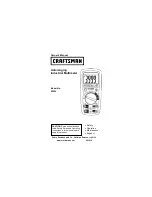
}
Pop-up text. It is activated by clicking the right mouse button when the cursor is
focused on a button or text field.
The RM-4 User Interface is described in detail in Chapter 5 of this manual.
Configuring the Ethernet Port
Choosing IP Addresses
Assigning the IP addresses to an RM-4 is important and must be based on the operation of the
entire network. Before configuring any RM-4, obtain information on the range of available IP
addresses and any operating firewalls and then carefully allocate the addresses of all of the RM-4s
of the network. Each RM-4 must be brought online separately, and have its IP Address changed to
its assigned value. Any changes in the Ethernet configuration of an RM-4 are easily tested: use
command
ping
to see if the route is set up. Any other computer on the network should be able to
ping the IP address to which the RM-4 is connected .
Configuring Serial Ports
Choosing baud rates
The baud rate to be used on a given serial link should be chosen such that the available bandwidth
is ample for the total inbound required throughput. The total inbound required throughput should
be calculated as the sum of the required throughput for each digitiser multiplexed into the same
RM-4 serial port. The throughput of a given digitiser is calculated using the following formula:
required throughput for a given digitiser
=
10
%
C
%
S
%
1.08
%
25
+
17
%
B
16
%
B
where
C = number of channels being digitised
S = sample rate of digitiser
B = number of bundles per packet
Note that the final terms are usually near unity, so they can be neglected for a first approximation.
The factor of 1.08 represents a typical compression ratio for data from a sensor at a quiet site; it is
the average number of bytes needed to represent one sample. During an event, this factor can go
as high as 4 for short periods of time.
The final term takes into account the fact that not every byte sent is a byte of data. The more
bundles configured to be in a packet, the smaller the proportion of the packet that is overhead, and
the closer this term approaches unity.
This throughput does not include State-of-Health or log message packets, but these packets are
normally a very small proportion of the throughput.
It is important to note that this formula does not include rerequested data. This is why baud rates
should always be chosen so that there is always plenty of spare bandwidth. When there is a fade
of some sort, and large blocks of data are rerequested simultaneously, this extra bandwidth ensures
that the missing data is collected quickly. In general, the more excess bandwidth, the less system
latency.
As an example, consider a serial port which is receiving data from a digitiser configured for 100 sps,
3 channels, and 15 bundles per packet. The required throughput is 3780 bits/s. A good baud rate
for the link, allowing lots of excess bandwidth, would be 9600 baud.
RM-4 Manual 13
4 - User Guide
Содержание RM-4
Страница 1: ...RM 4 Bridge Multiplexer Manual ...
Страница 2: ......
Страница 3: ...RM 4 Bridge Multiplexer User Manual ...
Страница 8: ...This page intentionally left blank ...
Страница 10: ...This page intentionally left blank ...
Страница 12: ...This page intentionally left blank ...
Страница 40: ...This page intentionally left blank ...
Страница 46: ...This page intentionally left blank ...
















































